Electrical Machines: Unit III: a. D.C. Motors
Torque and Speed Equations
Speed Regulation | DC Motors
Before analyzing the various characteristics of motors, let us revise the torque and speed equations as applied to various types of motors.
Torque
and Speed Equations
AU: Oct.-98, April-99, Dec.-05,
06,13,19 May-07, 08,09,11,15,17,19
•
Before analyzing the various characteristics of motors, let us revise the
torque and speed equations as applied to various types of motors.
T
α ϕ Ia ...................From torque equation
•
This is because, 0.159 PZ / A is a
constant for a given motor.
Now,
ϕ is the flux produced by the field winding and is proportional to the current
passing through the field winding.
Φ
α Ifield
•
But for various types of motors, current through the field winding is
different. Accordingly torque equation must be modified.
•
For a d.c. shunt motor, Ish is constant as long as supply voltage is
constant. Hence flux ϕ is also constant.
T
α Ia for shunt motors.
For
a d.c. series motor, Ise is same as Ia. Hence flux ϕ is proportional
to the armature current Ia.
T
∝ Ia ϕ ∝
Ia2
for series motors.
Similarly
as Eb = ϕPNZ / 60 A, we can write the speed
equation
as,
Eb
∝ ϕ N
N
∝ Eb / ϕ

•
These relations play an important role in understanding the various
characteristics of different types of motors.
1. Speed Regulation
•
The speed regulation for a d.c. motor is defined as the ratio of change in
speed corresponding to no load and full load condition to speed corresponding
to full load.
Mathematically
it is expressed as,
%
Speed regulation = Nno load -Nfull load / Nfull load
× 100
Ex. 4.11.1
A 230 V d.c. shunt motor, takes an
armature current of 3.33 A at rated voltage and at no load speed of 1000 r.p.m.
The resistances of the armature circuit and field circuit are 0.3 Ω and 160 Ω
respectively. The line current at full load and rated voltage is 40 A.
Calculate, at full load, the speed and the developed torque in case the
armature reaction weakens the no load flux by 4 %..
AU: Dec.-06, Marks 8
Sol. :
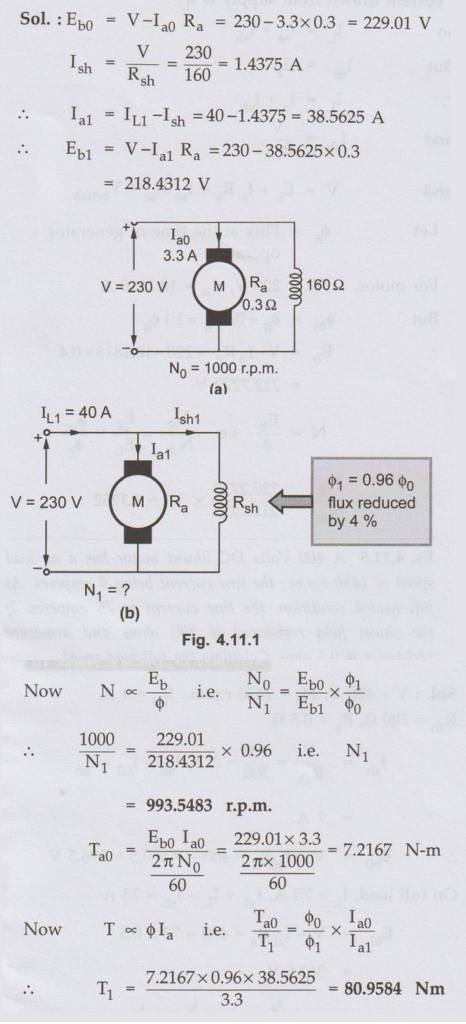
Ex. 4.11.2
A 220 V shunt motor has an armature
resistance of 0.5 Ω and takes an armature current of
40 A on a certain load. By how much must the main flux be reduced to raise the
speed by 50 % if the developed torque is constant? Neglect saturation and
armature reaction.
AU: May-08, Marks 8
Sol. :
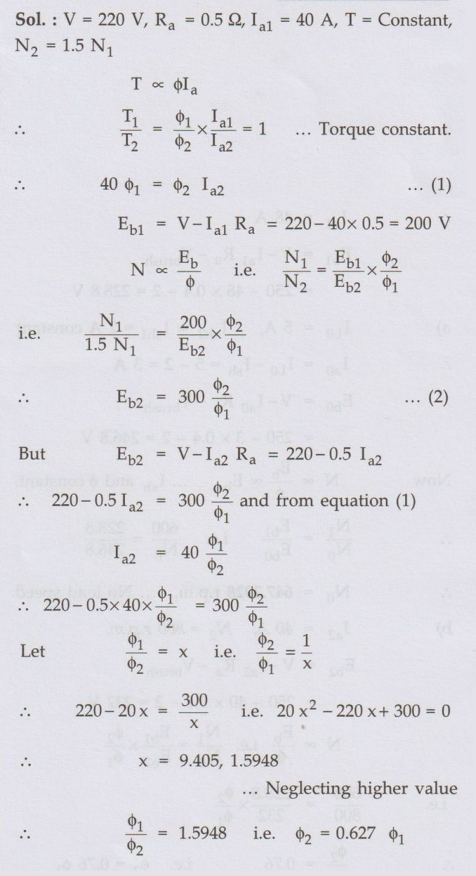
Ex. 4.11.3 A shunt motor runs at 600 r.p.m.
from 250 V supply and takes a line current of 50 A. Its armature and field
resistances are 0.4 Ω and 125 Ω
respectively. Neglecting the effects of armature reaction and allowing 2 V
brush drop. Calculate
1) The no load speed if the no load
line current is 5 A. 2) The percentage reduction in flux per pole in order that
the speed may be 800 r.p.m. when the armature current is 40A.
AU: Dec.-05, May-09, 17, Marks 8
Sol.
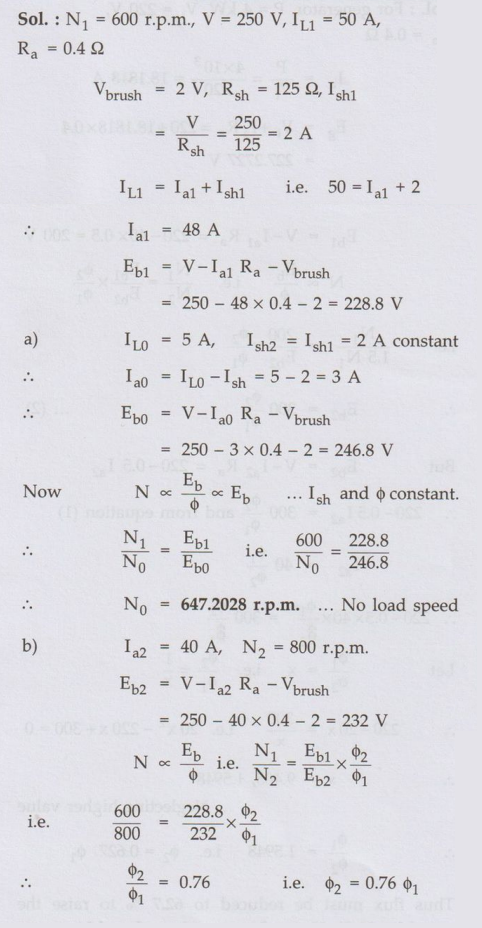
Thus
the flux must be reduced by 100 – 76 = 24 % to achieve change in speed from 600
r.p.m. to 800 r.p.m.
Ex 4.11.4
A 220 V d.c. generator supplies 4 kW at a
terminal voltage of 220 V, the armature resistance being 0.4 Ω. If the machine
is now operated as a motor at the same terminal voltage with the same armature
current, calculate the ratio of generator speed to motor speed. Assume that the
flux/pole is made to increase by 10% as the operation is changed over from
generator to motor.
AU: May-11, Marks 6
Sol.

Ex. 4.11.5 A 400 Volts DC Shunt motor has a
no load speed of 1450 r.p.m., the line current being 9 amperes. At full loaded
condition, the line current is 75 amperes. If the shunt field resistance is 200
ohms and armature resistance is 0.5 ohm. Calculate the full load speed.
AU May-15, Dec.-19, Marks 10
Sol. :
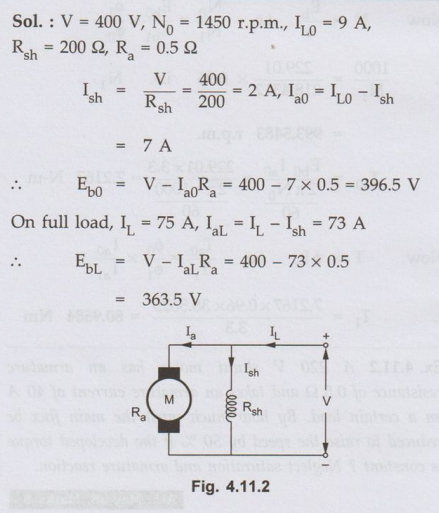
Ex. 4.11.6 A d.c. series motor is running
with a speed of 800 r.p.m. while taking a current of 20 A from the supply. If
the load is changed such that the current drawn by the motor is increased to 50
A, calculate the speed of the motor on new load. The armature and series field
winding resistances are 0.2 Ω and 0.3 Ω respectively. Assume the flux produced
is proportional to the current. Assume supply voltage as 250 V.
Sol.:
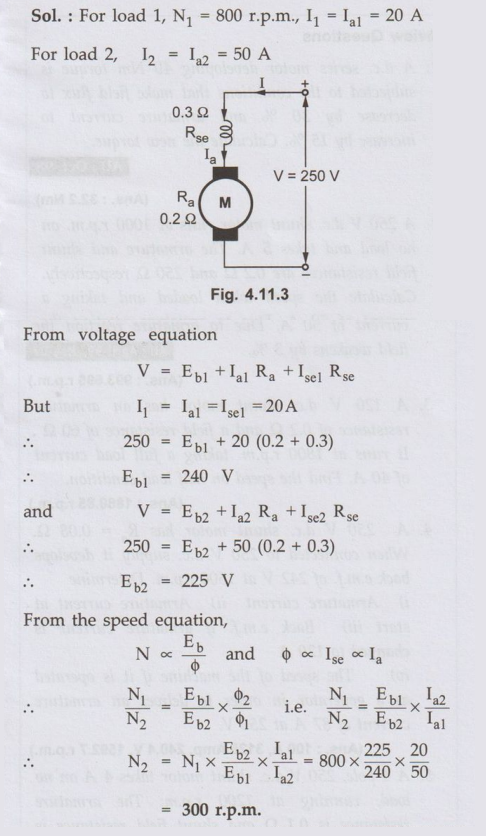
Ex. 4.11.7
A 100 kW dc shunt generator driven by a
belt from an engine runs at 750 rpm and is connected to 230 V dc mains. When
the belt breaks, it continues to run as a motor drawing 9 kW from the mains. At
what speed would it run? Given: Armature resistance = 0.018 Ω and field resistance
= 115 Q.
AU: Dec.-13, Marks 16
Sol.:
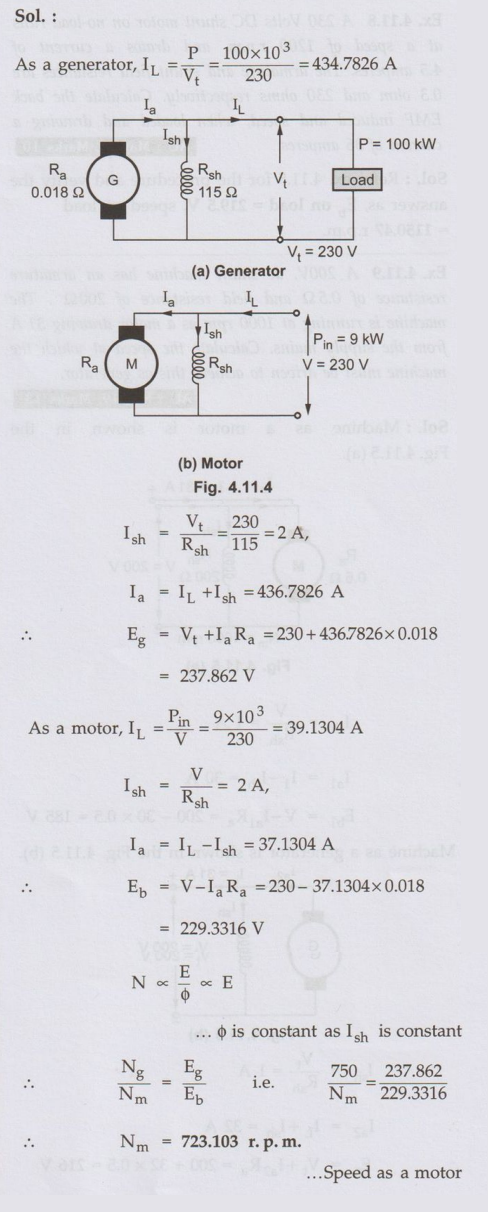
Ex. 4.11.8 A 230 Volts DC shunt motor on
no-load runs at a speed of 1200 r.p.m. and draws a current of 4.5 amperes. The
armature and shunt field reistances are 0.3 ohm and 230 ohms respectively.
Calculate the back EMF induced and speed, when loaded and drawing a current of
36 amperes.
AU May-15, Marks 10
Sol. Refer
ex. 4.11.5 for the procedure and verify the answer as, Eb on load = 219.5
V, speed on load = 1150.47 r.p.m.
Ex. 4.11.9
A 200V, dc shunt machine has an armature
resistance of 0.5 Ω and field resistance of 200
Ω. The machine is
running at 1000 rpm as a motor drawing 31 A from the supply mains. Calculate
the speed at which the machine must be driven to achieve this as generator.
AU: May-19, Marks 13
Sol. :
Machine
as a motor is shown in the Fig. 4.11.5 (a).
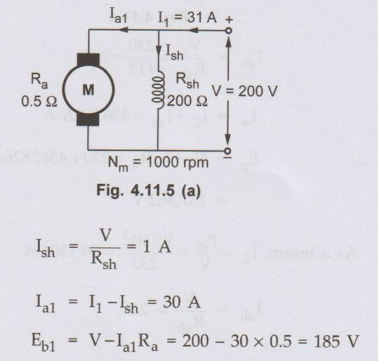
Machine
as a motor is shown in the Fig. 4.11.5 (b).
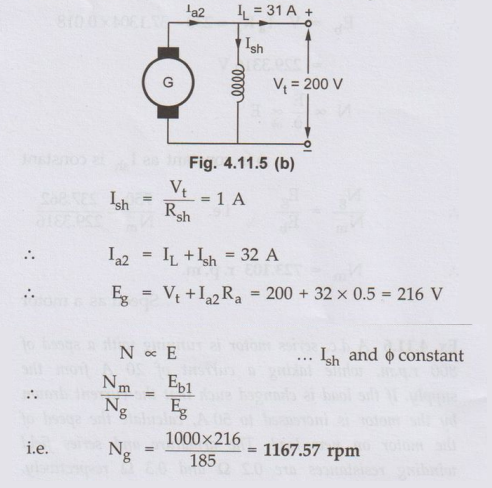
Review Questions
1. A d.c. series
motor developing 40 Nm torque is subjected to the conditions that make field
flux to decrease by 30 % and armature current to increase by 15%. Calculate the
new torque. AU: Oct.-98
(Ans.: 32.2 Nm)
2. A 250 V d.c. shunt motor runs at 1000 r.p.m. on no load and takes 5 A. The armature and shunt field resistances are 0.2 Ω and 250 Ω respectively. Calculate the speed when loaded and taking a current of 50 A. Due to armature reaction the field weakens by 3%. AU: April-99, May-07
(Ans.:
993.695 r.p.m.)
3. A 120 V d.c. shunt motor has an armature resistance of 0.2 Ω and a field resistance of 60 Ω. It runs at 1800 r.p.m. taking a full load current of 40 A. Find the speed on half load condition.
(Ans. 1860.85 r.p.m.)
4. A 250 V d.c. shunt
motor has Ra = 0.08 Ω When connected to 250 V d.c. supply it
develops back e.m.f. of 242 V at 1500 r.p.m. Determine
i) Armature current
ii) Armature current at start iii) Back e.m.f. if armature current is changed
to 120 A iv) The speed of the machine if it is operated as a generator in order
to deliver an armature current of 87 A at 250 V.
(Ans. 100 A, 3125
Amp, 240.4 V, 1592.7 r.p.m.)
5. A 4 pole, 250 V d.c. shunt motor takes 4 A on no load, running at 1200 r.p.m. The armature resistance is 0.1 Ω and shunt field resistance is 125 Ω. Total brush drop is 2 V. If it takes total current of 61 A on full load, calculate its full load speed. Assume that flux gets weakened by 5% on full load condition due to armature reaction.
(Ans. 1234.102 r.p.m.)
6. The full load output power of a d.c. shunt motor is 16 kW while connected to 250 V supply. Calculate the value of the starter resistance necessary to limit the starting current to 1.5 times the full load current. The full load efficiency of the motor is 80 % and resistance of the armature circuit is 0.18 Ω. Neglect shunt field current. Also calculate the back e.m.f. of the motor when the current has fallen to the full load value, assuming whole of the starter resistance still in the circuit.
(Ans.: 1.90332, 83.33 V)
Electrical Machines: Unit III: a. D.C. Motors : Tag: : Speed Regulation | DC Motors - Torque and Speed Equations
Related Topics
Related Subjects
Electrical Machines I
EE3303 EM 1 3rd Semester EEE Dept | 2021 Regulation | 3rd Semester EEE Dept 2021 Regulation
